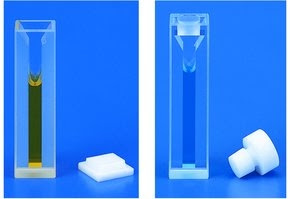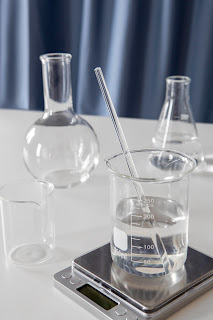 |
| 10 mm Quartz Cuvettes With Stoppers |
Alpha Nanotech Inc. is a Canada-based tech company who serves the need of academic research laboratories and industrial fields around the globe. Our mission is to ease off the research pressure and to deliver the high-quality research materials.
 |
| 10 mm Quartz Cuvettes With Stoppers |
Introduction
In the world of analytical chemistry and
spectroscopy, precision and accuracy are of paramount importance. Researchers
and scientists constantly seek ways to optimize their experimental setups to
obtain reliable results. One crucial component that can make a significant
difference in ultraviolet (UV) spectroscopy experiments is the choice of
cuvettes. Ultraviolet quartz cuvettes with PTFE screw caps and septa are the
ideal solution for researchers looking to elevate the quality of their UV
spectroscopy experiments.
What Are UV Quartz Cuvettes?
UV quartz cuvettes are specialized
cells or containers used to hold liquid samples for analysis in UV
spectrophotometers. These cuvettes are designed to be transparent in the UV
range, allowing for accurate measurements of samples with UV absorption or
fluorescence properties. Here, we'll explore the advantages of Ultravioletquartz cells with PTFE screw caps and septa.
 |
| Ultraviolet Quartz Cells With PTFE Screw Caps And Septa |
Advantages of UV Quartz Cuvettes with
PTFE Caps
Superior Optical Properties:
Ultraviolet quartz cuvettes are made
from high-purity quartz, which offers outstanding optical clarity. This clarity
is essential in UV spectroscopy, as any impurities or imperfections in the
cuvette material can distort the results. PTFE caps enhance this clarity by
providing a chemically inert and optically transparent sealing solution.
Chemical Compatibility:
PTFE (polytetrafluoroethylene) is known
for its exceptional chemical resistance. When used as caps and septa for UV
quartz cuvettes, it ensures that the cuvette contents remain uncontaminated by
the sealing material. This is particularly important when working with
sensitive or reactive samples.
Leak-Free Sealing:
PTFE screw caps and septa create a
reliable, leak-free seal, preventing any sample leakage or evaporation during
the experiment. This is crucial for maintaining the integrity of the sample and
ensuring accurate and consistent measurements.
Reusability:
UV quartz cuvettes with PTFE caps
are designed for multiple uses. The robust PTFE material can withstand repeated
sealing and unsealing without degradation. This reusability not only saves
costs but also reduces waste, contributing to a more sustainable laboratory
practice.
Versatility:
These cuvettes are suitable for a wide
range of applications, including DNA and protein analysis, chemical kinetics,
and environmental monitoring. Their versatility makes them a valuable tool for researchers
in various fields.
Introduction
In the fascinating world of
nanotechnology, silica nanoparticles have emerged as versatile and powerful
materials with a wide range of applications. Among the many variations of
silica nanoparticles, iron oxide beads
coated with silica and amine-terminated magnetic silica beads stand out
for their unique properties and usefulness in various fields. In this blog
post, we'll delve into the characteristics and applications of these two
remarkable nanoparticles.
I. Iron Oxide Beads Coated with Silica
Iron oxide beads coated with silica, often referred to as core-shell
nanoparticles, are a remarkable fusion of two distinct materials.
 |
| Iron Oxide Beads Coated With Silica |
Structure and Composition:
Key Properties:
Applications:
II. Amine-Terminated Magnetic Silica
Beads
Amine-terminated magnetic silica beads are another exciting variation of silica
nanoparticles with unique properties:
Structure and Composition:
Key Properties:
Applications:
Introduction:
When it comes to analytical chemistry
and spectroscopy, precision and accuracy are of utmost importance. Researchers,
scientists, and professionals in various fields rely on high-quality
instruments and accessories to obtain reliable results. One crucial accessory
in the world of UV spectroscopy is the UV quartz cuvette. In this blog post, we
will explore the significance of 10 mm quartz cuvettes with stoppers,
specifically UV Fused Quartz Cuvettes, and how they play a crucial role in UV
spectrophotometry.
UV Quartz Cuvettes - What Are They?
UV quartz cuvettes, also known as
spectrophotometer cells, are small, transparent containers designed to hold
liquid samples for UV-visible spectroscopy. They are commonly used in various
applications, including chemical analysis, biochemistry, and environmental
science. The unique properties of UV quartz cuvettes make them the preferred
choice for UV spectrophotometry.
UV Fused Quartz Cuvettes - The Epitome
of Quality:
UV Fused Quartz Cuvettes are the gold standard when it comes to
UV spectroscopy. These cuvettes are made from high-purity fused quartz, which
offers exceptional optical properties. Here are some key features that make UV
Fused Quartz Cuvettes stand out:
10 mm Quartz Cuvettes with Stoppers -
Added Convenience:
The 10 mm quartz cuvettes withstoppers path length of these cuvettes is a common choice for many UV
spectrophotometers. It strikes a balance between sample volume and sensitivity.
Additionally, the stoppers provide a secure closure to prevent contamination
and evaporation of samples during measurements.
 |
| 10 mm Quartz Cuvettes With Stoppers |
Applications:
UV quartz cuvettes find applications in
a wide range of fields, including:
Conclusion:
In the realm of UV spectrophotometry,
the choice of cuvette can make a significant difference in the quality and
reliability of your results. UV Fused Quartz Cuvettes, such as the 10 mm quartz
cuvettes with stoppers, offer unparalleled precision, UV transmittance, and
chemical resistance. Whether you're a seasoned researcher or a newcomer to the
world of spectroscopy, investing in high-quality cuvettes is a step toward
ensuring the accuracy of your UV measurements.
Silica nanoparticles have emerged as a
game-changing innovation in the field of nanotechnology, offering a wide range
of applications that span from medical diagnostics to environmental
remediation. These tiny particles, typically measuring less than 100 nanometers
in diameter, have unique properties that make them invaluable in various
industries. In this blog post, we'll explore the world of silica nanoparticles,
with a special focus on magnetic silica nanoparticles and their exciting
potential.
Understanding Silica Nanoparticles
Silica, or silicon dioxide, is one of
the most abundant compounds on Earth. In its nanoparticle form, it exhibits
extraordinary properties such as a high surface area and exceptional
biocompatibility. These characteristics have led to a myriad of applications in
fields like medicine, electronics, and materials science.
Medical Applications
Silica nanoparticles are utilized in drug delivery systems
due to their ability to encapsulate and protect pharmaceutical compounds. This
technology allows for precise drug targeting, reducing side effects and
increasing therapeutic efficacy. Moreover, these nanoparticles can be
functionalized to enable site-specific drug release, enhancing the treatment of
various diseases.
Environmental Remediation
Silica nanoparticles have been employed
in environmental cleanup efforts. Their large surface area makes them effective
in adsorbing heavy metals, pollutants, and contaminants from water and soil.
This property makes them a vital tool in addressing environmental challenges
and ensuring a healthier planet.
Magnetic Silica Nanoparticles
One fascinating subset of silica
nanoparticles is the magnetic silica nanoparticles. These nanoparticles
are embedded with magnetic materials like iron oxide, combining the unique
properties of both silica and magnetism. This hybrid material opens up an
entirely new world of possibilities.
 |
| Silica Nanoparticles |
Biomedical Applications
Magnetic silica nanoparticles have
garnered significant attention in the biomedical field. Their magnetic
properties enable precise targeting and controlled movement within the body
when subjected to an external magnetic field. This is particularly useful in
the field of cancer treatment, where they can be used for targeted drug
delivery or hyperthermia therapy, where targeted tissues are heated to destroy
cancer cells.
Environmental Sensing
In environmental monitoring, magnetic
silica nanoparticles can be functionalized with specific receptors or ligands
to detect pollutants and contaminants. These nanoparticles can be dispersed in
water or air, and their magnetic properties allow for easy collection and
analysis. This approach simplifies and accelerates environmental monitoring
processes.
Laboratories are the facilities where a wide range of works are done on a daily basis apart from doing the tests with different chemicals and solutions. One of the most vital works that is done at such a facility is the grinding and mixing of the hard particles. To do this, first these hard particles need to be crushed and grind so that the powder form of these hard particles can be obtained. While doing this grinding and crushing operations, you also need to take ample care of safety like aspect. So you must use the right kind of equipment or device that can help with safe crushing and grinding of these hard particles. One of the best equipment used these days for such works is the mortar and pestle. And when this product is made from agate like material, it can be very effective and safe on the use. Laboratory agate mortar and pestle 100mm is the one that can help you with grinding and crushing like in a safe possible way.

laboratory agate mortar
and pestle 100mm
· Turns solid chemicals into fine powder in a very safe way
There are certain solid chemicals which you need to turn into the smaller pieces or you might need to make their powdered form. Once they come to the fine powder like form, it also becomes easier for you to dissolve them with required solution so that desired chemical can be obtained. This is where the use of the laboratory agate mortar and pestle 100mm can bring handy help.
· A preferred material to make mortar and pestle
Agate has always remained as the most preferred material to make the mortar and pestle that can be used at the laboratories. Agate as a material is very hard with comparison to the porcelain and glass.

Alphananotechne.com is a leading supplier of best quality lab testing materials for high-end experimentation. You can order for UV fused quartz cuvettes for completing your research on life science in your labs. Buy the best quality products for lab testing and scientific experiments, visit our website today!
 |
| UV fused quartz cuvettes |
